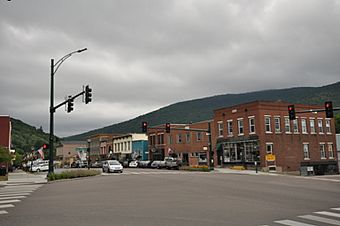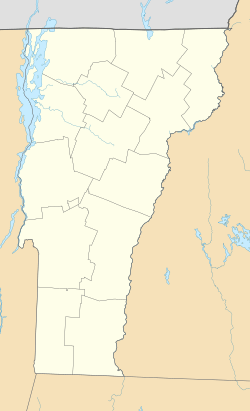Bristol Downtown Historic District facts for kids
Quick facts for kids |
|
|
Bristol Downtown Historic District
|
|
 |
|
| Location | Main St., Bristol, Vermont |
|---|---|
| Area | 8 acres (3.2 ha) |
| Architect | Daman, C.W. |
| Architectural style | Italianate, Mixed (more Than 2 Styles From Different Periods) |
| NRHP reference No. | 83003203 |
| Added to NRHP | February 3, 1983 |
The Bristol Downtown Historic District is a special area in Bristol, Vermont. It shows what the town's main business area looked like in the late 1800s. Bristol started as a farming town. But later, it became a small center for making things, especially wood products. This historic downtown area is located on Main Street. It has many different styles of old buildings. It was added to the National Register of Historic Places in 1983. This means it's an important place to protect because of its history.
Discovering Downtown Bristol's Past
Bristol, Vermont, is found on the western side of Vermont's Green Mountains. People first settled here in the 1780s. For many years, it was mostly a farming community. The town center helped local farmers. It had places to sell their crops. There were also sawmills to cut wood and gristmills to grind grain.
From Farms to Factories
Things started to change in 1862. A factory opened near the town center. It was by the New Haven River. This factory made wooden items. Soon, it began making special wooden products. By the early 1900s, this factory became very important. It was one of the biggest suppliers of these products in the country. They also made many other types of wood items. However, these businesses slowed down after World War I.
Main Street's Look Today
Downtown Bristol is one long block of Main Street. This street is also known as Vermont Route 116. It runs east-west, just north of the New Haven River. The historic area starts at a main crossing. Here, Main Street meets North, South, and West Streets. Bristol's town hall is at this intersection.
East of this crossing, Main Street is full of old buildings. There are more than a dozen commercial buildings. They were built in the late 1800s and early 1900s. Most are two or three stories tall. They are usually made of brick. On the north side of Main Street, you'll see the Union Block. This is one large building with seven different shops. Behind the buildings on the south side is the Kilburn Mill. It was built in 1924. This mill is one of the last old factories left in town.



